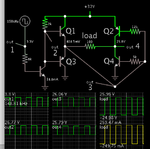Follow along with the video below to see how to install our site as a web app on your home screen.
Note: This feature may not be available in some browsers.
Hi,
What about a half bridge?
There are integrated circuits.
Klaus

The specification is still ambiguous. What's the meaning of 19 mA? Maximum current tolerated by the source or 170 ohm output impedance? What's 20V, peak to peak or simple peak (= 40V pk-pk)? Any rise/fall-time requirements? What kind of load is driven by the driver?I am inputting 150khz 3.3V 19.38mA D.C Square Wave in order to ouput 150khz 20V P2k .2A A.C Square Wave
View attachment 149740
I am inputting 150khz 3.3V 19.38mA D.C Square Wave in order to ouput 150khz 20V P2k .2A A.C Square Wave

